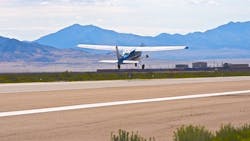Air Force Research Laboratory successfully conducts first flight of ROBOpilot unmanned air platform
By 88th Air Base Wing Public Affairs
WRIGHT-PATTERSON AIR FORCE BASE, Ohio – The Air Force Research Laboratory and DZYNE Technologies Incorporated successfully completed a two-hour initial flight of a robotic pilot unmanned conversion program called ROBOpilot Aug. 9 at Dugway Proving Ground in Utah.
“Imagine being able to rapidly and affordably convert a general aviation aircraft, like a Cessna or Piper, into an unmanned aerial vehicle, having it fly a mission autonomously, and then returning it back to its original manned configuration,” said Dr. Alok Das, Senior Scientist with AFRL’s Center for Rapid Innovation. “All of this is achieved without making permanent modifications to the aircraft.”
As the vision for AFRL’s CRI Small Business Innovative Research project with DZYNE Technologies of Irvine, California, ROBOpilot interacts with an aircraft the same way as a human pilot would.
For example, the system “grabs” the yoke, pushes on the rudders and brakes, controls the throttle, flips the appropriate switches and reads the dashboard gauges the same way a pilot does. At the same time, the system uses sensors, like GPS and an Inertial Measurement Unit, for situational awareness and information gathering. A computer analyzes these details to make decisions on how to best control the flight.
Users remove the pilot’s seat and install a frame in its place, which contains all the equipment necessary to control the aircraft including actuators, electronics, cameras, power systems and a robotic arm.
Das explains that this non-invasive approach to robotically piloted aircraft leverages existing commercial technology and components. ROBOpilot incorporates many subsystems and lessons learned from previous AFRL and DZYNE Technology aircraft conversion programs.
AFRL developed the system using a Direct to Phase II SBIR contract. During the past year, AFRL and DZYNE designed, built and tested ROBOpilot. Engineers demonstrated the initial concept in a RedBird FMX simulator, a full motion, feature-rich advanced aviation training device. ROBOpilot successfully completed simulated autonomous takeoffs, mission navigation and landings in both nominal and off-nominal conditions in this Federal Aviation Administration-certified trainer.
As an early adopter of creating disruptive innovation through paradigm shifts, AFRL established the Center for Rapid Innovation in 2006 to streamline AFRL’s application of new and existing technologies to address dynamic changes in air, space, ground, and cyber battlespaces and solve evolving and urgent operational challenges. The execution of this unique process uses diverse subject matter expertise and a collaborative government-industry technical and management capability to rapidly develop, test and deploy innovative prototype solutions for dynamic operational environments.
CRI routinely uses the SBIR program to identify both disruptive technology and innovative engineering talent for its projects. Working with teams of innovative small businesses, CRI has demonstrated numerous operational successes such as back-packable, precision strike platforms for high-value fleeting targets; counter-improvised explosive device (IED); counter drone capabilities; and secure on-the-move communications. Several efforts have even transitioned to Air Force Programs of Record.


